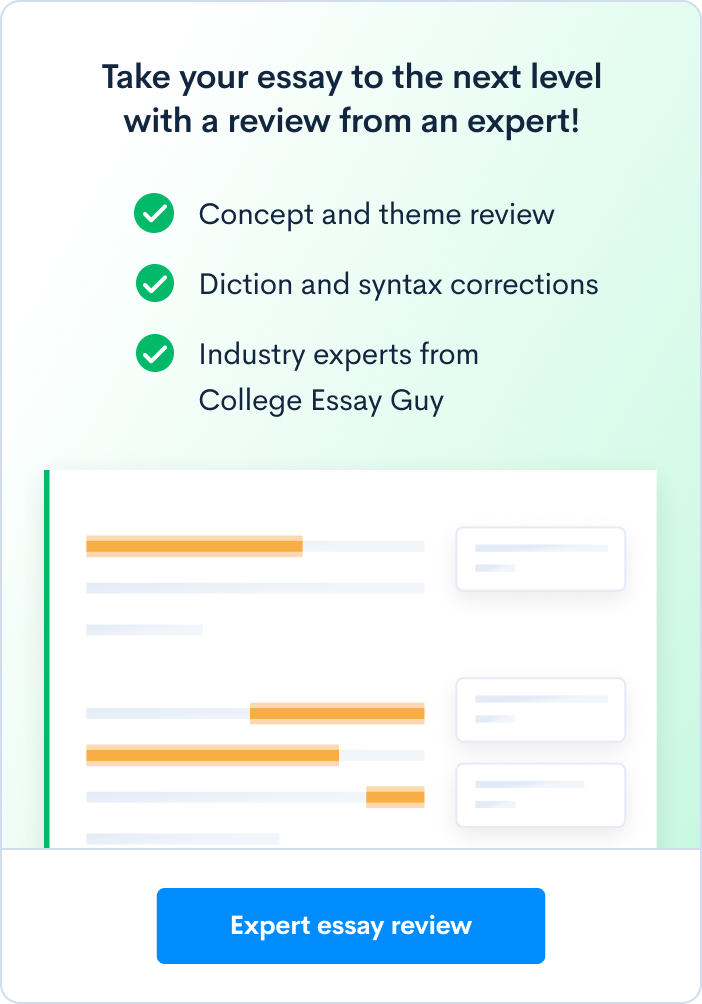Why This Common App Essay Worked: Prompt #2 “The Lessons We Take…”
Working on your Common App essay and thinking about this prompt? Then read on to learn how to answer this in a compelling essay and read two examples of essays that worked!
The lessons we take from obstacles we encounter can be fundamental to later success. Recount a time when you faced a challenge, setback, or failure. How did it affect you, and what did you learn from the experience?
Everyone has faced obstacles of some kind: a struggle with health, a failed personal project, or a financial hardship. This prompt is relevant to most people applying to college – which isn’t a bad thing.
The most important part of writing a personal statement is to show admissions committees how you think about the world and respond to challenges rather than to come up with an entirely new angle or topic. That being said, you probably should not write about a time that you received a bad grade or lost a sports game. Those narratives are overdone and won’t allow admissions officers to get insight into your unique perspective.
What colleges want to see is your ability to be mature, resilient, and thoughtful; they want evidence that you are able to handle the independence and challenges of college. Show the admissions committee how you faced an obstacle, but responded with a creative and dignified solution instead of giving up. Be vulnerable – show your insecurity, regret, and fears. Finally, as indicated in the prompt, describe what you learned and the experience’s permanent significance. If you can’t think of such an impact, you probably shouldn’t be writing your personal statement about the situation. Remember, your personal statement is like your introduction – make sure you’re telling them an important story!
The linearity of this prompt allows you to follow a pretty straightforward outline for your essay: context, obstacle, reaction, result. Putting these parts together, you’ll have a well constructed personal essay! We outlined the basic questions that should be answered in response to this prompt by component (context, obstacle, reaction, and result), but these are fluid and may be placed in whatever section makes the most sense for your narrative.
Below, CollegeVine breaks down a finalized version of a real essay that we worked on with a student who addressed this prompt.
Make Sure to Establish Enough Context
Outline the situation leading up to the event. Make sure you hit the basics: who, what, where, why? It is also important to note whatever your pre-state was.
For example, the author of the sample essay overcame his fear of public speaking to pay tribute to a beloved coach. This triumph would have been much less meaningful had he not outlined his fear earlier in the essay. You need to give the admissions committee enough detail to understand how you evolved.
“Getting beat is one thing – it’s part of competing – but I want no part in losing.” Coach Rob Stark’s motto never fails to remind me of his encouragement on early-morning bus rides to track meets around the state. I’ve always appreciated the phrase, but an experience last June helped me understand its more profound, universal meaning.
Stark, as we affectionately call him, has coached track at my high school for 25 years. His care, dedication, and emphasis on developing good character has left an enduring impact on me and hundreds of other students. Not only did he help me discover my talent and love for running, but he also taught me the importance of commitment and discipline and to approach every endeavor with the passion and intensity that I bring to running. When I learned a neighboring high school had dedicated their track to a longtime coach, I felt that Stark deserved similar honors.
Here, the author describes why he was so fond of his coach as well as his desire to dedicate the school track to Stark. He hits the who (Coach Stark), what (desire to dedicate the track in Stark’s honor), where (high school), and why (the important lessons that Stark has imparted).
The author also hints at his future personal development – “to approach every endeavor with the passion and intensity that I bring to running.” He also implies that he will fail to meet his original goal in the opening quote, “getting beat is one thing – it’s part of competing – but I want no part in losing.” Hinting at the lesson you will eventually learn is an effective strategy. It allows to admissions committees to read your personal statement with the final lesson in mind, making the essay simpler to follow and priming the reader so that your conclusion is easy to understand.
The author comes across as caring by wishing to dedicate the track to his coach, thoughtful in the way he is aware of the impact that Stark has had on him, and driven in his ability to identify and pursue a selfless project. These qualities will appeal to a college admissions committee which wishes to build an intellectual and kind community on campus.
Clearly Define the Obstacle
Who or what got in your way? To what extent were you responsible for the obstacle?
Our school district’s board of education indicated they would only dedicate our track to Stark if I could demonstrate that he was extraordinary. I took charge and mobilized my teammates to distribute petitions, reach out to alumni, and compile statistics on the many team and individual champions Stark had coached over the years. We received astounding support, collecting almost 3,000 signatures and pages of endorsements from across the community. With help from my teammates, I presented this evidence to the board.
They didn’t bite.
Here, the author makes it clear that he came up with a plan in which he felt confident. The author does a good job of showing, rather than telling, the ways in which he addressed the issue at hand. Instead of saying he put together a plan, the author lists individual efforts that he took, which allows the reader a fuller understanding of the lengths to which he went. This is crucial as it gives the admissions committee better insight into the way in which the author approaches lofty goals; he uses many approaches (petitions, alumni testimonies, and statistics) to support his argument.
The short and separated sentence – “They didn’t bite.” – comes as a contrast to the long list of preparations that the author had organized. It implies that the board was both curt and absolute in their rejection of his plan. Here, we learn of the real obstacle – and lesson – that the essay focuses on: the importance of not giving up. The message of the opening line of the essay – “Getting beat is one thing – it’s part of competing – but I want no part in losing,” – is relevant here. The author experienced initial failure, but isn’t passively accepting a loss just yet. In the next paragraph, the author describes how he tried to persuade the school board a second time.
Go In-depth About Your Reaction
This is the most important part. Colleges want to know how you think about things or handle stressful situations!
Did you make a plan? Collaborate with teammates? Have an open conversation with your parents? How did you work around the challenge? It is important to also describe your emotional response; were you hurt, invigorated, sad, angry, surprised? In what ways did you handle this emotion? Was your response mature? What was your first (emotional) response? How did your thoughts or feelings change over time? Finally, what plan did you make?
Most members argued that dedicating the track was a low priority. Knowing that we had to act quickly to convince them of its importance, I called a team meeting where we drafted a rebuttal for the next board meeting. To my surprise, they chose me to deliver it. I was far from the best public speaker in the group, and I felt nervous about going before the unsympathetic board again. However, at that second meeting, I discovered that I enjoy articulating and arguing for something that I’m passionate about.
Public speaking resembles a cross country race. Walking to the starting line, you have to trust your training and quell your last minute doubts. When the gun fires, you can’t think too hard about anything; your performance has to be instinctual, natural, even relaxed. At the next board meeting, the podium was my starting line. As I walked up to it, familiar butterflies fluttered in my stomach. Instead of the track stretching out in front of me, I faced the vast audience of teachers, board members, and my teammates. I felt my adrenaline build, and reassured myself: I’ve put in the work, my argument is powerful and sound. As the board president told me to introduce myself, I heard, “runners set” in the back of my mind. She finished speaking, and Bang! The brief silence was the gunshot for me to begin.
In this section, the author shows the admissions committee how resilient he is by organizing a rebuttal to the board’s initial ruling. The detail about being selected by his team to present is also crucial; it shows that he has been identified by his peers as a leader.
Moreover, his hesitation to present (his pre-state) is essential to the later connection he makes between running and speaking publicly with ease. He handles a negative emotion (nervousness) with ease and maturity, reframing it as an opportunity to be a powerful speaker and sound orator. Crucially, the author doesn’t just tell us that he’s nervous, but brings us into the physical and psychological experience.
This detailed description allows the reader to empathize with the author; we have all experienced nervousness and know how difficult it can be to overcome, and the author allows the reader to mentally enter an anxious state. Putting the reader into your emotional experience (here, being anxious) makes whatever reaction you have (here, speaking well in front of a group of people) seem more impressive. Instead of simply telling us that he spoke in front of the board, the author brings us into the room with him to highlight his accomplishments!
The author also makes a connection to overcoming his fear of public speaking to performing well under pressure at track meets. In this way, the author is able to connect all of the valuable life skills that track taught him without doing so in a cliche or contrived fashion. This connection is creative and ties the narrative back in with the essay’s broader themes. It shows the admissions committee that the author is capable of understanding how and why he behaves the way he does, which is a sign of maturity. Colleges are more interested in how you think about the things you do than they are interested in the things you do.
Colleges want to see that you have an optimistic and opportunistic approach to obstacles. People generally like people who are positive, which the author certainly comes across as here. Instead of being shut down by a challenge, show admissions committees how you used it to fuel your fire!
Discuss the End Result
Talk about to what degree your efforts were successful. Even if you didn’t meet your original goal, what did you learn? Importantly, how are you applying these lessons now?
The next few minutes blurred together, but when the dust settled, I knew from the board members’ expressions and the audience’s thunderous approval that I had run quite a race. Unfortunately, it wasn’t enough; the board voted down our proposal. I was disappointed, but proud of myself, my team, and our collaboration off the track. We stood up for a cause we believed in, and I overcame my worries about being a leader. Although I discovered that changing the status quo through an elected body can be a painstakingly difficult process and requires perseverance, I learned that I enjoy the challenges this effort offers. Last month, one of the school board members joked that I had become a “regular” – I now often show up to meetings to advocate for a variety of causes, including better environmental practices in cafeterias and safer equipment for athletes.
Just as Stark taught me, I worked passionately to achieve my goal. I may have been beaten when I appealed to the board, but I certainly didn’t lose, and that would have made Stark proud.
Despite being disappointed in his failure to meet his original goal, the author responds positively: proud of his and his teammates’ hard work.
The author also addresses his post-state by answering the last question of the prompt (how the obstacle affected you and what you learned from the experience). In this example, the author’s post-state is uncovering a passion for advocacy and evolving into a more confident leader. He outlines specifically the way in which he learned to stand up for the causes he believes in and overcame his fears of public speaking and leadership.
Importantly, the author’s resiliency is embodied by not being dissuaded by his first unsuccessful attempt to make a change. He shows that he is applying the lessons he learned “to advocate for a variety of causes, including better environmental practices in cafeterias and safer equipment.” This hint at his other interests, environmental and safety policies, encourages the admissions committee to learn more. Ideally, the author’s mention of these interests should be backed up in his activity list – perhaps, for example, through involvement with his school’s Sustainability Club or recent recycling initiative.
Finally, the author pays respect to the man who first inspired him. Importantly, this essay allows the author to explore all that he learned by being an athlete without writing a cliche essay on the topic.
Want More Insight?
The original version of this essay along with our edits and higher-level notes can be found in a download here. We’ve also thrown in a second sample essay to help you see more of the same patterns and strategies discussed above in action. For insight on the other prompts, be sure to check out our other Common App posts.
Want help with your college essays to improve your admissions chances? Sign up for your free CollegeVine account and get access to our essay guides and courses. You can also get your essay peer-reviewed and improve your own writing skills by reviewing other students’ essays.





